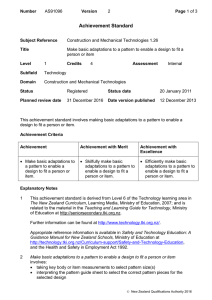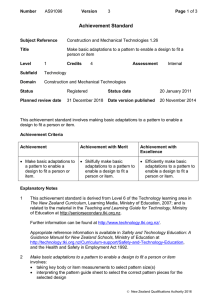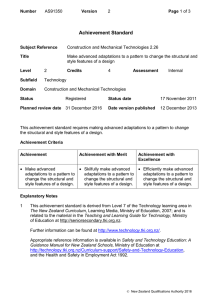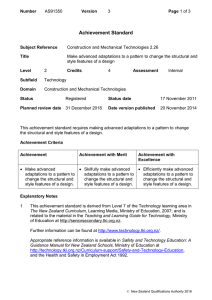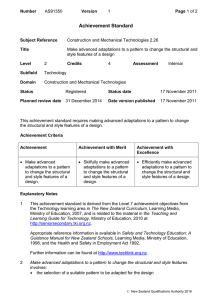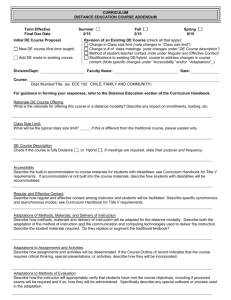Achievement Standard
advertisement
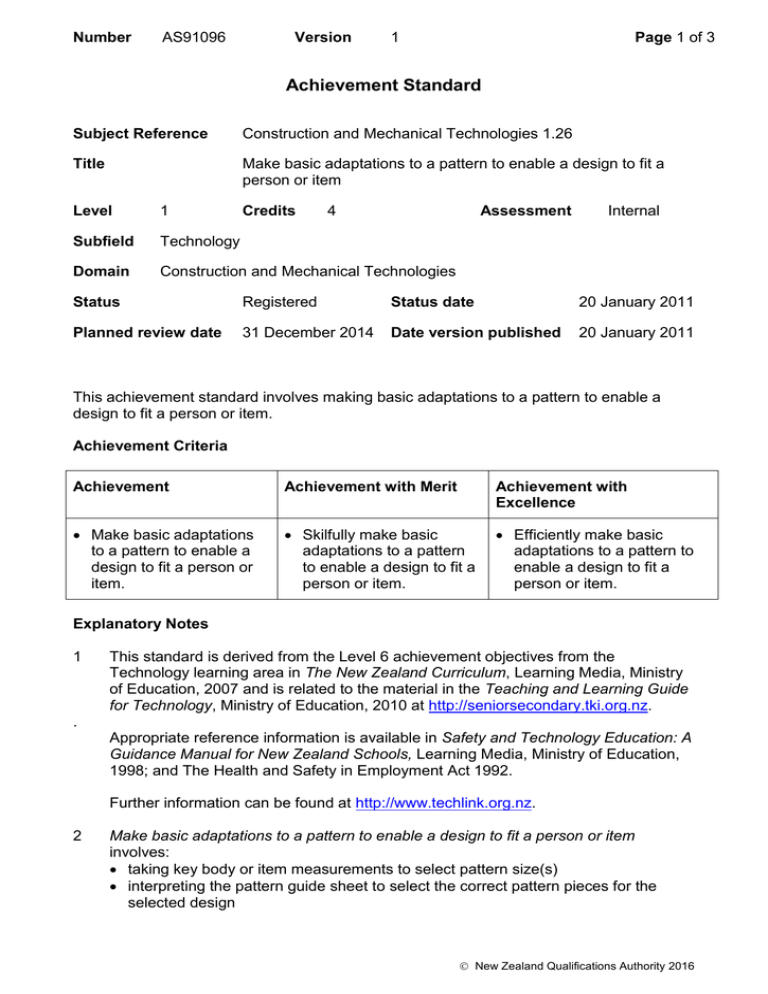
Number AS91096 Version 1 Page 1 of 3 Achievement Standard Subject Reference Construction and Mechanical Technologies 1.26 Title Make basic adaptations to a pattern to enable a design to fit a person or item Level 1 Credits 4 Assessment Subfield Technology Domain Construction and Mechanical Technologies Internal Status Registered Status date 20 January 2011 Planned review date 31 December 2014 Date version published 20 January 2011 This achievement standard involves making basic adaptations to a pattern to enable a design to fit a person or item. Achievement Criteria Achievement Achievement with Merit Achievement with Excellence Make basic adaptations to a pattern to enable a design to fit a person or item. Skilfully make basic adaptations to a pattern to enable a design to fit a person or item. Efficiently make basic adaptations to a pattern to enable a design to fit a person or item. Explanatory Notes 1 This standard is derived from the Level 6 achievement objectives from the Technology learning area in The New Zealand Curriculum, Learning Media, Ministry of Education, 2007 and is related to the material in the Teaching and Learning Guide for Technology, Ministry of Education, 2010 at http://seniorsecondary.tki.org.nz. . Appropriate reference information is available in Safety and Technology Education: A Guidance Manual for New Zealand Schools, Learning Media, Ministry of Education, 1998; and The Health and Safety in Employment Act 1992. Further information can be found at http://www.techlink.org.nz. 2 Make basic adaptations to a pattern to enable a design to fit a person or item involves: taking key body or item measurements to select pattern size(s) interpreting the pattern guide sheet to select the correct pattern pieces for the selected design New Zealand Qualifications Authority 2016 Number AS91096 Version 1 Page 2 of 3 undertaking basic adaptation of a pattern using key measurements taken interpreting the pattern symbols and using the guide sheet to correctly place pattern pieces to suit material width and type developing a construction plan, using appropriate language, symbols and diagrams using the plan to construct a toile or mock up testing toile or mock up, and refining the pattern if necessary, to ensure the adapted pattern interprets the design and provides the correct fit for the body or item. Skilfully make basic adaptations to a pattern to enable a design to fit a person or item involves: showing independence and accuracy when making basic adaptations, developing construction plans and testing the toile or mock up. Efficiently make basic adaptations to a pattern to enable a design to fit a person or item involves: making basic adaptations, developing construction plans and testing the toile or mock up in a manner that economises time, effort and materials. 3 A pattern suitable to adapt and use in this standard refers to a commercial pattern that is professionally produced, or an alternative that provides similar structure and guidance using technical language and symbols. This may include but is not limited to teacher provided blocks or computer generated patterns, with accompanying guide sheets. The pattern must include a minimum of three pattern pieces and may be provided by the teacher or selected by the student. 4 The pattern design will be for a textile or alternative soft material product which requires ‘fitting’ to meet the requirements of a specific person or item. Products may include but are not limited to – garments, equipment coverings, and furnishings. 5 Materials include textiles or alternative soft materials and may include but are not limited to natural and synthetic: fibres, yarns, fabrics, leather, and vinyl. 6 A construction plan would require students to interpret and modify the pattern information and select the appropriate information for their design, and plan a logical order of construction. 7 Examples of basic adaptations include but are not limited to – lengthening, shortening, widening, simple shape changes. 8 Toile or mock up refers to a particular method of functional modelling involving the production of a sample product. Its purpose is to translate the pattern into 3 dimensions to check all aspects of the design have been interpreted appropriately and provide the correct fit for the person or item. New Zealand Qualifications Authority 2016 Number AS91096 Version 1 Page 3 of 3 9 Tests used to determine if the pattern provides the correct fit include but are not limited to checking – toile/mock up accurately reflects design, correct size, appropriate opening to ensure ease of putting on and taking off, darts placed to shape for fullness, shoulder length is accurate, fit is comfortable for wearer. 10 Conditions of Assessment related to this achievement standard can be found at http://www.tki.org.nz/e/community/ncea/conditions-assessment.php. Replacement Information This achievement standard replaced unit standard 16834. Quality Assurance 1 Providers and Industry Training Organisations must be accredited by NZQA before they can register credits from assessment against achievement standards. 2 Accredited providers and Industry Training Organisations assessing against achievement standards must engage with the moderation system that applies to those achievement standards. Accreditation and Moderation Action Plan (AMAP) reference 0233 New Zealand Qualifications Authority 2016
